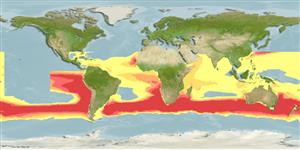>
Zeiformes (Dories) >
Oreosomatidae (Oreos) > Oreosomatinae
Etymology: Allocyttus: Greek, allos = other + Greek, kyttaros, kytos = a convex cavity.
Environment: milieu / climate zone / depth range / distribution range
Ecologia
marinhas batipelágico; oceanódromo (Ref. 51243); intervalo de profundidade 0 - 1800 m (Ref. 50610), usually 800 - 1200 m (Ref. 6545). Deep-water; 28°N - 58°S
Eastern Atlantic: off Mauritania, Gulf of Guinea, Namibia and South Africa. Western Atlantic: off Suriname, southern Brazil and Uruguay. Western Indian Ocean: Mozambique Channel, Walters Bank. Eastern Indian Ocean: East Indian and West Australian Ridge, Australia. South Pacific: New Zealand and off Chile. Records from the North Pacific belong to Allocyttus folletti. Also Ref. 26139).
Length at first maturity / Tamanho / Peso / Idade
Maturity: Lm 28.0, range 23 - ? cm
Max length : 42.5 cm TL macho/indeterminado; (Ref. 27159); peso máx. Publicado: 2.0 kg (Ref. 27124); Idade máx. registada: 140 anos (Ref. 39383)
Espinhos dorsais (total): 5 - 8; Raios dorsais moles (total): 28-33; Espinhos anais 2-3; Raios anais moles: 26 - 31. Adults blackish black in color; prejuveniles silvery, back greenish with large grey blotches that disappears at about 12 cm (Ref. 6548).
Occurs on the continental slope (Ref. 9563), forming large shoals over rough ground near pinnacles and canyons (Ref. 6390). Juveniles are pelagic and inhabit oceanic waters in depths of less than 1000 m (Ref. 27230). They tend to be dispersed over smooth grounds (Ref. 6390). Feeds on shrimps, cephalopods, and fishes (Ref. 6548). The eggs float near the sea surface and the larvae also inhabit surface waters (Ref. 6390). Trawl catch rates for warty oreos, and for oreos in general, show no evidence of vertical migration during day or night (Ref. 27150), even though many of the planktonic species consumed by this species undergo daily migrations within the water column (Ref. 6390).
Life cycle and mating behavior
Maturidade | Reprodução | Desova | Ovos | Fecundidade | Larvas
Displays seasonally synchronised reproduction.
Karrer, C., 1990. Oreosomatidae. p. 637-640. In J.C. Quero, J.C. Hureau, C. Karrer, A. Post and L. Saldanha (eds.) Check-list of the fishes of the eastern tropical Atlantic (CLOFETA). JNICT, Lisbon; SEI, Paris; and UNESCO, Paris. Vol. 2. (Ref. 6545)
Categoria na Lista Vermelha da IUCN (Ref. 130435)
Ameaça para o homem
Harmless
Utilização humana
Pescarias: pouco comercial
Mais informação
ReferênciasAquaculturaPerfil para aquaculturaEstirpesGenéticaElectrophoresesHereditariedadeDoençasProcessamentoNutrientsMass conversion
ColaboradoresFotografiasStamps, Coins Misc.SonsCiguateraVelocidadeTipo de nataçãoÁrea branquialOutras referênciasCérebrosVisão
Ferramentas
Relatórios especiais
Descarregue XML
Fontes da internet
Estimates based on models
Preferred temperature (Ref.
123201): 3.4 - 6.9, mean 4.9 °C (based on 252 cells).
Phylogenetic diversity index (Ref.
82804): PD
50 = 0.5635 [Uniqueness, from 0.5 = low to 2.0 = high].
Bayesian length-weight: a=0.01380 (0.00803 - 0.02372), b=3.05 (2.89 - 3.21), in cm total length, based on LWR estimates for this species & (Sub)family-body (Ref.
93245).
Nível Trófico (Ref.
69278): 4.2 ±0.73 se; based on food items.
Generation time: 36.7 ( na - na) years. Estimated as median ln(3)/K based on 1
growth studies.
Resiliência (Ref.
120179): Muito baixo, tempo mínimo de duplicação da população maior que 14 anos (tmax=140).
Fishing Vulnerability (Ref.
59153): High to very high vulnerability (68 of 100).
Nutrients (Ref.
124155): Calcium = 8.71 [2.32, 45.18] mg/100g; Iron = 0.301 [0.083, 1.049] mg/100g; Protein = 17.9 [15.0, 20.9] %; Omega3 = 0.176 [0.050, 0.601] g/100g; Selenium = 10.8 [2.2, 49.9] μg/100g; VitaminA = 45.9 [3.9, 565.9] μg/100g; Zinc = 0.473 [0.182, 1.247] mg/100g (wet weight);
